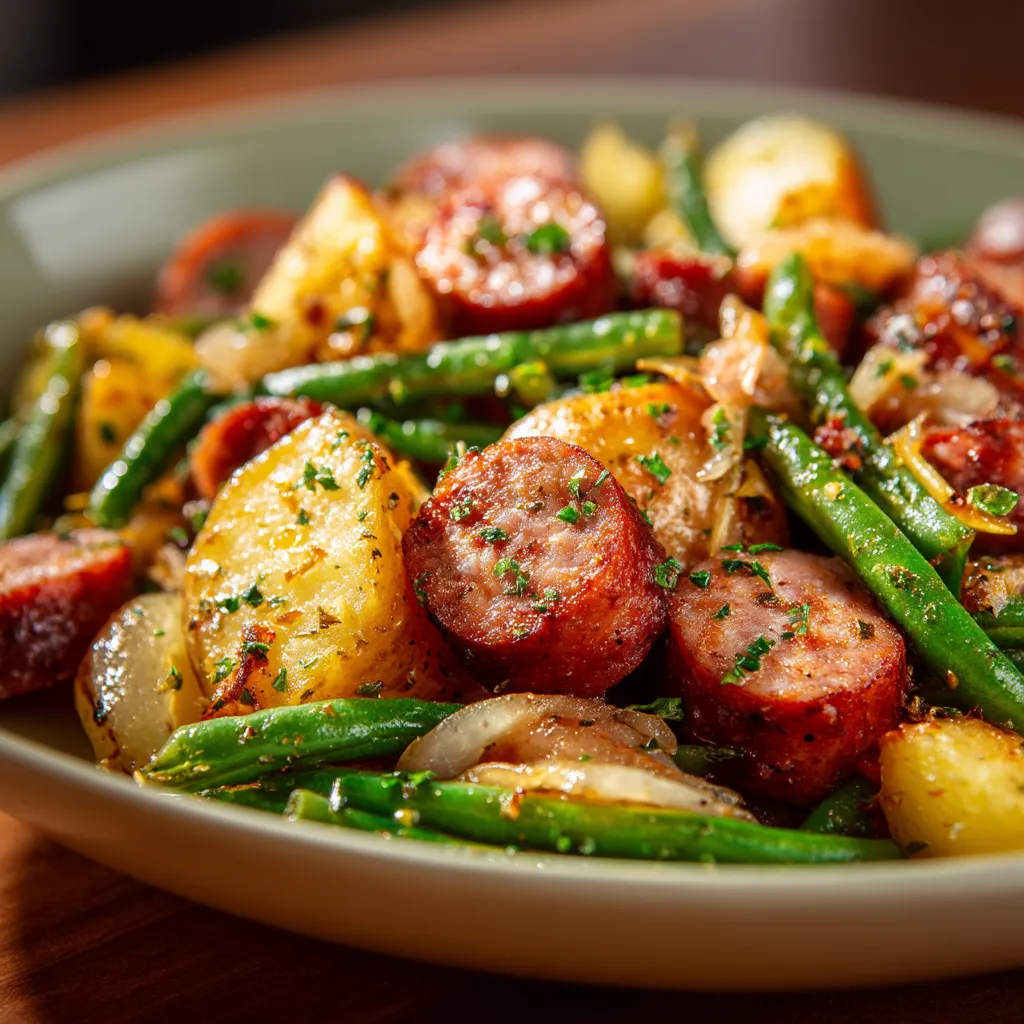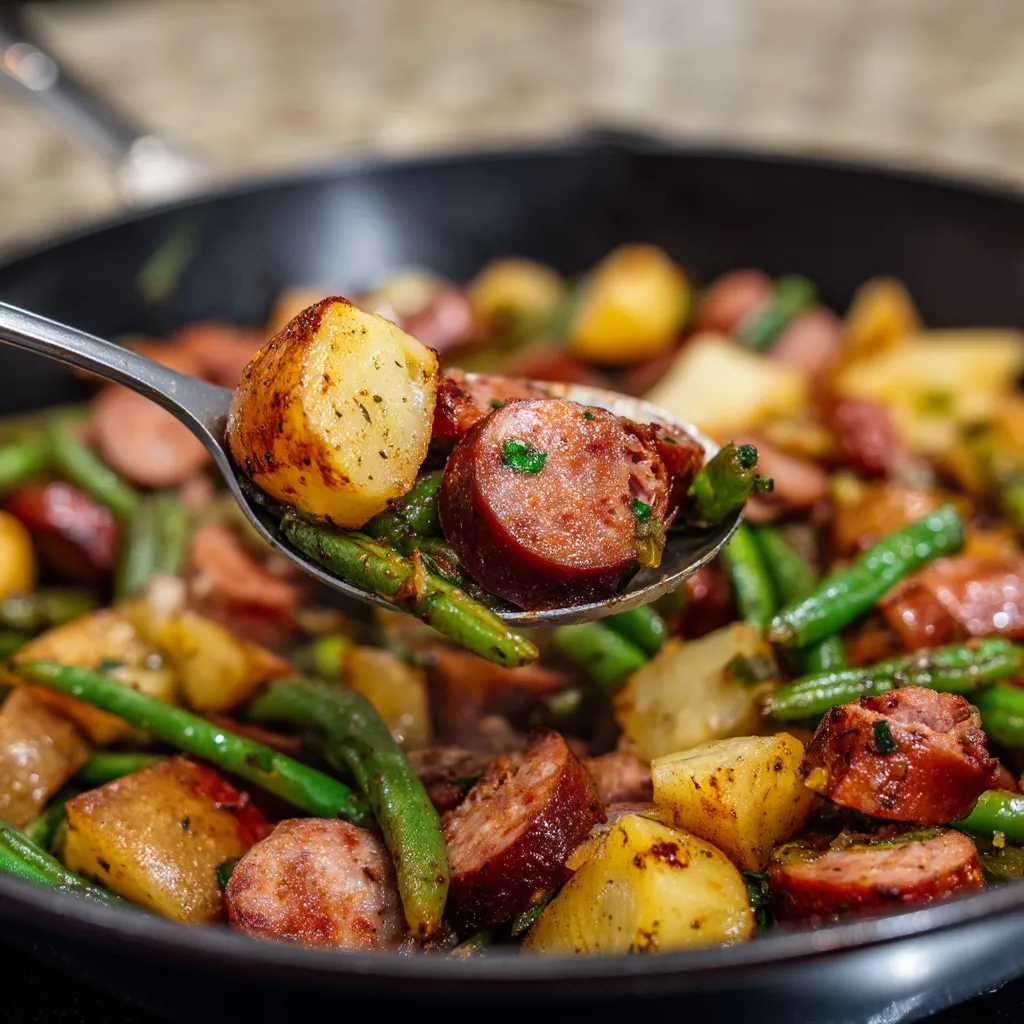 Save to Pinterest
Save to Pinterest This smoked sausage and green bean skillet has become my weeknight dinner hero. With minimal prep and just one pan to clean, it delivers maximum flavor in minimal time while keeping my family satisfied and my sanity intact.
I first created this recipe during a particularly hectic week when I needed something substantial yet simple. What started as a fridge cleanout experiment has since become one of our most requested family meals.
Ingredients
- Smoked sausage: Provides rich savory flavor that infuses the entire dish. Look for high quality options with visible spices for the best taste experience.
- Olive oil: Helps achieve perfect browning on the sausage without sticking.
- Onion and garlic: Create the aromatic foundation. Use sweet yellow onions for a milder flavor profile.
- Baby potatoes: Hold their shape better than larger varieties. Choose ones similar in size for even cooking.
- Chicken broth: Adds depth while helping steam the vegetables. Homemade provides best flavor but boxed works perfectly too.
- Smoked paprika: Enhances the smoky notes from the sausage. The Spanish variety offers superior flavor intensity.
- Green beans: Provide freshness and texture. Select bright beans with no browning for optimal results.
- Butter: Added at the finish creates a silky glaze that brings everything together. European style with higher fat content works wonders here.
Step by Step Instructions
- Sear the sausage:
- Heat olive oil in a large skillet over medium high heat until shimmering but not smoking. Add sliced sausage in a single layer allowing space between pieces. Cook undisturbed for 2 minutes then flip and cook 2–3 minutes more until deeply browned on both sides. This caramelization creates rich flavor compounds that become the foundation of the dish. Remove sausage to a plate.
- Build the flavor base:
- Add chopped onion to the same pan with all those wonderful sausage drippings. Sauté for 2 minutes until translucent but not browned stirring occasionally. Add minced garlic and cook just 30 seconds until fragrant being careful not to burn it as this would create bitterness.
- Cook the potatoes:
- Add halved potatoes cut side down first for better browning. Pour in broth which will release all the flavorful fond from the bottom of the pan. Sprinkle with smoked paprika salt and pepper then cover tightly. Allow to simmer for 10–12 minutes checking occasionally to make sure liquid hasn't completely evaporated adding a splash more if needed. The potatoes should offer just slight resistance when pierced with a fork.
- Incorporate vegetables and finish:
- Add green beans distributing them evenly throughout the pan then place sausage pieces back on top. Cover again and simmer 5–7 minutes until beans turn bright green and become tender crisp. The vegetables will steam while absorbing all the wonderful flavors in the pan.
- Final touches:
- Remove the lid allowing any excess moisture to evaporate for about 1 minute. Stir in butter if using allowing it to melt and create a light glossy sauce that coats everything. Taste and adjust seasoning as needed a pinch more salt or fresh cracked pepper often brings all the flavors into perfect balance.
 Save to Pinterest
Save to Pinterest The smoked paprika is my secret ingredient here. I discovered its transformative power during a cooking class in Barcelona where the instructor used it in nearly everything. While it might seem like a small addition it bridges the flavors of the sausage and vegetables creating harmony in the dish.
Perfect Pairings
This skillet dinner stands beautifully on its own but pairs wonderfully with crusty bread for soaking up the flavorful juices. For a lighter option serve with a simple side salad dressed with lemon vinaigrette which provides bright acidity to balance the richness of the sausage.
Storage and Reheating
Store leftovers in an airtight container in the refrigerator for up to three days. The flavors actually deepen overnight making this excellent for meal prep. Reheat gently in a covered skillet with a tablespoon of water to create steam or microwave at 70% power to prevent the sausage from becoming tough and the potatoes from drying out.
Ingredient Swaps
This recipe welcomes substitutions based on what you have available. Turkey or chicken sausage works beautifully for a lighter option. Sweet potatoes can replace regular potatoes for additional nutritional benefits and a touch of sweetness. During summer months try adding cherry tomatoes in the last few minutes of cooking for a burst of acidity that brightens the entire dish.
Seasonal Variations
Adapt this skillet throughout the year by incorporating seasonal vegetables. Spring asparagus summer zucchini fall brussels sprouts or winter kale all work wonderfully in place of or alongside the green beans. Each variation creates an entirely new experience while maintaining the comforting essence of the original recipe.
 Save to Pinterest
Save to Pinterest Common Recipe Questions
- → Can I make this casserole ahead of time?
Yes, you can prepare this casserole up to 24 hours ahead. Complete all stovetop steps, allow to cool, then refrigerate. When ready to serve, bake for an additional 10-15 minutes beyond the recipe time to ensure it's heated through.
- → What can I substitute for heavy cream?
For a lighter version, you can substitute half-and-half or a mixture of whole milk and Greek yogurt. For dairy-free options, full-fat coconut milk or cashew cream work well, though they will add a subtle flavor to the dish.
- → How do I store and reheat leftovers?
Store leftovers in an airtight container in the refrigerator for up to 3 days. Reheat in the microwave in 30-second intervals or in the oven at 350°F (175°C) for about 15 minutes until heated through.
- → Can I freeze this chicken casserole?
Yes, you can freeze it for up to 3 months. For best results, freeze before adding the optional topping. Thaw overnight in the refrigerator and bake at 375°F (190°C) for 30-35 minutes or until thoroughly heated. Add fresh topping before baking if desired.
- → What vegetables can I substitute in this dish?
This casserole is versatile - try bell peppers, green beans, peas, or leeks in spring/summer, or switch to root vegetables like parsnips, turnips, or butternut squash in fall/winter. Adjust cooking times accordingly as heartier vegetables need longer to soften.
- → How can I make this dish dairy-free?
Replace butter with olive oil or plant-based butter, substitute heavy cream with full-fat coconut milk or cashew cream, and omit the Parmesan or use a dairy-free cheese alternative. The sauce may be slightly thinner but will still be delicious.